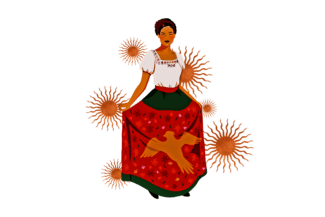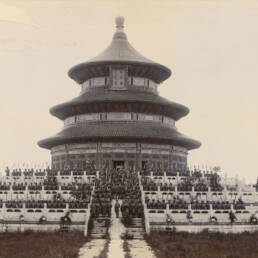Mirrah
How a kidnapped girl from Mughal India inspired Mexico’s traditional costume
Mexican art and culture has a deep-rooted connection with symbolism, cult and their fabled history. The bright colours, quirky patterns and magical textures found in the Mexican culture have often taken inspiration from religious, social and cultural rituals of Mayan and Aztec civilisations. If you ever attend the festival Cinco de Mayo, you will probably notice the local Mexican girls draped in traditional colourful dresses— dancing, cheering and celebrating; but what you can hardly ever guess is that the origin of these gorgeous Mexican costumes actually traces back to Mughal India.
Cinco de Mayo is an annual Mexican celebration, observed on May 5, to honour the Mexican Army’s victory over the French Empire at the Battle of Puebla, fought on the same day, in 1862. On this day, women dance in vibrant costumes including white embroidered blouses made of silk, embellished with tiny decorative beads, and floral skirts decorated with sparkling ornaments. They also wear vibrant rebozo[note 1] shawls with gorgeous geometric patterns on them. This is the traditional attire for urban Mexican women of the Puebla region and is known as China Poblana. Although in modern times, wearing this ethnic costume is limited only to the holiday celebration, the costume is also often considered synonymous with the eternal Mexican womanhood.

The origin of China Poblana is alluded to in the legend of Catarina de San Juan, a 17th-century religious woman. She lived in the old city of Puebla, located in Central Mexico, in the valley of the volcanic soils. The captivating story of Catarina de San Juan draws a fascinating connection to a noble family of Mughal India, and her perilous yet epic journey of becoming a cultural icon in the faraway land of Central Mexico.
According to most historians, Catarina de San Juan was born around 1606 in India, during the Mughal regime. During the era of Emperor Akbar and Jahangir, Mughal India was a vibrant confluence of culture, religion and trade. Though her exact place of birth is still unknown, it is believed to be in one of the opulent north Indian cities of that time. She was born into a Muslim family, and named Mirra by her parents, who were believed to have a royal lineage.
When Mirra was 10, in an effort to evade an alleged Turkish invasion, her family emigrated to Surat, one of the strongholds of the Mughal empire on the western banks and a hive of the European traders. Meanwhile, the Mughals and Portuguese were on the brink of a war over several disputes. Surat, on the other hand, had become the epicentre of a complex socio-political situation due to its vicinity to south Asian maritime trade and attracting growing interests from several European forces. In 1612, off the coast of Suvali, in a village near the Surat, East India Company and the Portuguese galleons were involved in a fierce battle. Today the Battle of Suvali is recognised to be the genesis of the Indian Navy. However, the western banks also saw another force rising to power in the early 17th century. When the Bay of Bengal had witnessed the atrocities of Portuguese Harmads and Arakanese Maghs, the Arabian Sea endured the wrath of the pirates, who began preying on the spice trade.
At the onset of such a volatile political situation around Surat, one day, a group of Portuguese buccaneers noticed a little girl with her adolescent brother playing on the beach. The girl was Mirra, barely 10 then. The pirates abducted her and set off on a voyage across the Malabar coastline to Cochin. In that era, the Malavares pirates of Cochin were among the most feared ones, although it is still inconclusive exactly which pirate group abducted Mirra from Surat. Mirra was brought to Cochin, and she was soon baptised by the Portuguese Jesuits, a religious missionary group of the Catholic Church. She was named Catarina de San Juan following her baptisation and was transported to Manila through the Bay of Bengal. She spent days crammed in a small space under the deck of the ship. Manila was waiting for her.

Manila, in the early 17th century, was the hub of the notorious Trans-Pacific slave trade, a planet-scale framework to supply Asian slaves to Spanish America and New Spain[note 2]. The slaves, who were abducted from various Asian nations, were transported to Acapulco in Mexico via the famous Manila Galleon, where they were sold in exchange for a few hundred Pesos. Her long stay in the slave markets of the Philippines was not so pleasant. She was being starved, abused and sexually humiliated. Eventually, a Spanish merchant purchased her from an auction in Manilla and she had embarked on Manilla Galleon for her final destination, Mexico.
During a heavy monsoon in 1619, Catarina finally arrived at the port of Acapulco, on the Pacific coast of Mexico. She had to make a perilous journey crossing 400 kilometres through the terrains of via de China, travelling north to Mexico City and eventually reaching Puebla in around 1621. Her final destination was the residence of Miguel de Sosa, one of the wealthy Portuguese army captains of the city. His wife Margarita was in need of a domestic servant and thus Mirra, the kidnapped slave from India, became a housemaid in the colonial city of Puebla. She lived the remainder of her life in this city, far from home and family.
During the early 17th century, numerous slaves from different Asian origins were shipped to Mexico on Manila Galleon. Traditionally, the Spanish slave owners categorized them all as Chinos, the slaves from China, ignoring their cultural and ethnic origins. Keeping the norm intact, Catarina was also stamped as a Chino. Her roots of Indian origin began to fade with time.
Over time, Catarina established herself as an efficient domestic help, who understood the Hispanic household culture, and after the death of Miguel, she was emancipated and started to help a cleric named Father Pedro Suárez in the proceedings of the church. Father Suárez had arranged her wedding to one of his other servants of Asian origin, Domingo. However, her wedding night turned out to be a little unconventional. According to her biographers, the spirit of naked Jesus Christ appeared in her dream and advised her to maintain her chastity. This marked the commencement of her spiritual journey, where she devoted her life to the Church and became a prominent religious figure.
After Domingo’s death, Catarina became a devoted servant of the church and gradually came to be recognised for her visions and prophecy. She lived the rest of her life in a cell at one of the neighbourhood houses. She hardly went out of the town. She even predicted the deaths of several prominent personalities including the Viceroy of New Spain. Her work for needy and poverty-stricken city dwellers also garnered public sentiment. Her popularity as a miraculous woman had gone to inspire myriads of texts, paintings, music and Hispanic Baroque art. After her death, she was almost transformed into sainthood. Over time her legend has been asserted by imagination, and she has been remembered as the China Poblana, the slave girl from Puebla, who became a nun. The place where she lived has now been commemorated as a hotel[note 3], where a ceramic plaque reads in Spanish “In this house died the enchanting princess of the Great Mughal, Mirra …” and a porcelain statue of a smiling woman with hands on her hip draped in the ethnic China Poblana costume, has become an identity of the city since then.

Today the legend of Catarina de San Juan has been credited to the origin of the China Poblana costume of local women in Mexican folklore, and many believe that the fashion has originated from the Indian fabrics and dresses that Catarina brought from Mughal India, her homeland. However, a segment of modern scholars unanimously believes that the connection between the costume and 17th-century Indian slave is still inconclusive. Somehow, the slave woman from India, who was always seen modestly draped in dark woollen clothes, magically transformed to an image of the one in a colourful dress, which thereafter became an emblem of Mexican femininity. The words became a legend, the legend became a myth. The church had a significant contribution in passing down the elaborated legend and imagination of a pious Asian woman, who embraced Catholic practise. Catarina de San Juan served a major religious and commercial purpose for the Mexican Catholic church. The church was in need of an exemplary face to promote the ideology of religious devotion among the women in the society and Catarina was just the perfect icon for the purpose. There were at least two hagiographies[note 4] written following her death by her confessors. The three-volume biography by Alonso Ramos was the most voluminous body of work published in colonial Spain. Apart from detailing meticulous life events, the hagiographies also contain enough elaboration of her religious cult, virtuous life and devotion to the church helping to establish her legend as a national identity.
The link between Catarina de San Juan, China Poblana and the Mexican iconic folk costume is still being heavily contested among historians. The image of a virtuous woman, when portrayed as a national identity, invokes an interesting realm of complex socio-political implication. Although, the direct connection between China Poblana, the 19th-century colourful costume and China Poblana, the 17th-century legendary nun, is still being debated, but there is no denying that the legend of Catarina de San Juan has survived for centuries and has been deeply associated to the narrative constructing her image as a symbol of modern Mexican womanhood. The extraordinary life of Mirra, from a royal resident of the Mughal Empire, to becoming a slave of a remote Mexican town, and eventually achieving sainthood and inspiring one of the iconic costumes of Mexico, will always be an astounding folklore for generations to come.
Notes
- A rebozo is a long flat garment, very similar to a shawl, worn mostly by women in Mexico.
- New Spain included all of the territory claimed by Spain Colonial force in North America and the Caribbean
- Casona de la China Poblana is a restored 17th-century mansion in the historic city centre commemorating the house where Catarina de San Juan lived, having suits named after Mirra, Samarcanda, El Gran Mogol, Agra, Akbar etc.
- A hagiography an idealized biography of a saint or a religious leader.
References & Bibliography
- De Orellana, Margarita, Michelle Suderman, Gutierre Tibón, Pedro Ángel Palou, Roshni Rustomji-Kerns, Guillermo Prieto, Richard Moszka, Ricardo Pérez Montfort, Jason Lange, and Emma Yanes. “China Poblana.” Artes De México, no. 66 (2003): 65-80. Accessed March 23, 2021. http://www.jstor.org/stable/24315516.
- Risse, Kate. “Catarina De San Juan and the China Poblana: From Spiritual Humility to Civil Obedience.” Confluencia 18, no. 1 (2002): 70-80. Accessed March 23, 2021. http://www.jstor.org/stable/27922884.
- Bailey, G. A.. “A Mughal Princess in Baroque New Spain. Catarina de San Juan (1606-1688), the china poblana.” (1997).
- Seijas, Tatiana. “Catarina De San Juan: China Slave and Popular Saint.” Chapter. In Asian Slaves in Colonial Mexico: From Chinos to Indians, 8–31. Cambridge Latin American Studies. Cambridge: Cambridge University Press, 2014. doi:10.1017/CBO9781107477841.002.
- MALONI, RUBY, and RUBY MALONY. “PIRACY IN INDIAN WATERS IN THE SEVENTEENTH CENTURY.” Proceedings of the Indian History Congress 52 (1991): 410-15. Accessed March 23, 2021. http://www.jstor.org/stable/44142635.
- Seijas, Tatiana. “The Diversity and Reach of the Manila Slave Market.” Chapter. In Asian Slaves in Colonial Mexico: From Chinos to Indians, 32–72. Cambridge Latin American Studies. Cambridge: Cambridge University Press, 2014. doi:10.1017/CBO9781107477841.003.








